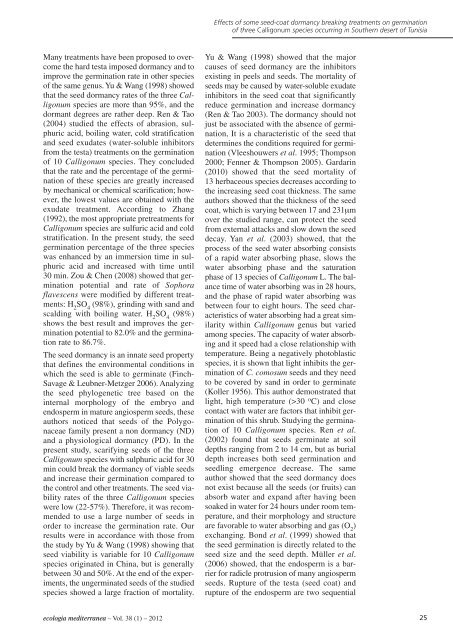International Journal of Mediterranean Ecology - Ecologia ...
International Journal of Mediterranean Ecology - Ecologia ...
International Journal of Mediterranean Ecology - Ecologia ...
You also want an ePaper? Increase the reach of your titles
YUMPU automatically turns print PDFs into web optimized ePapers that Google loves.
Many treatments have been proposed to overcome<br />
the hard testa imposed dormancy and to<br />
improve the germination rate in other species<br />
<strong>of</strong> the same genus. Yu & Wang (1998) showed<br />
that the seed dormancy rates <strong>of</strong> the three Calligonum<br />
species are more than 95%, and the<br />
dormant degrees are rather deep. Ren & Tao<br />
(2004) studied the effects <strong>of</strong> abrasion, sulphuric<br />
acid, boiling water, cold stratification<br />
and seed exudates (water-soluble inhibitors<br />
from the testa) treatments on the germination<br />
<strong>of</strong> 10 Calligonum species. They concluded<br />
that the rate and the percentage <strong>of</strong> the germination<br />
<strong>of</strong> these species are greatly increased<br />
by mechanical or chemical scarification; however,<br />
the lowest values are obtained with the<br />
exudate treatment. According to Zhang<br />
(1992), the most appropriate pretreatments for<br />
Calligonum species are sulfuric acid and cold<br />
stratification. In the present study, the seed<br />
germination percentage <strong>of</strong> the three species<br />
was enhanced by an immersion time in sulphuric<br />
acid and increased with time until<br />
30 min. Zou & Chen (2008) showed that germination<br />
potential and rate <strong>of</strong> Sophora<br />
flavescens were modified by different treatments:<br />
H2SO4 (98%), grinding with sand and<br />
scalding with boiling water. H2SO4 (98%)<br />
shows the best result and improves the germination<br />
potential to 82.0% and the germination<br />
rate to 86.7%.<br />
The seed dormancy is an innate seed property<br />
that defines the environmental conditions in<br />
which the seed is able to germinate (Finch-<br />
Savage & Leubner-Metzger 2006). Analyzing<br />
the seed phylogenetic tree based on the<br />
internal morphology <strong>of</strong> the embryo and<br />
endosperm in mature angiosperm seeds, these<br />
authors noticed that seeds <strong>of</strong> the Polygonaceae<br />
family present a non dormancy (ND)<br />
and a physiological dormancy (PD). In the<br />
present study, scarifying seeds <strong>of</strong> the three<br />
Calligonum species with sulphuric acid for 30<br />
min could break the dormancy <strong>of</strong> viable seeds<br />
and increase their germination compared to<br />
the control and other treatments. The seed viability<br />
rates <strong>of</strong> the three Calligonum species<br />
were low (22-57%). Therefore, it was recommended<br />
to use a large number <strong>of</strong> seeds in<br />
order to increase the germination rate. Our<br />
results were in accordance with those from<br />
the study by Yu & Wang (1998) showing that<br />
seed viability is variable for 10 Calligonum<br />
species originated in China, but is generally<br />
between 30 and 50%. At the end <strong>of</strong> the experiments,<br />
the ungerminated seeds <strong>of</strong> the studied<br />
species showed a large fraction <strong>of</strong> mortality.<br />
ecologia mediterranea – Vol. 38 (1) – 2012<br />
Effects <strong>of</strong> some seed-coat dormancy breaking treatments on germination<br />
<strong>of</strong> three Calligonum species occurring in Southern desert <strong>of</strong> Tunisia<br />
Yu & Wang (1998) showed that the major<br />
causes <strong>of</strong> seed dormancy are the inhibitors<br />
existing in peels and seeds. The mortality <strong>of</strong><br />
seeds may be caused by water-soluble exudate<br />
inhibitors in the seed coat that significantly<br />
reduce germination and increase dormancy<br />
(Ren & Tao 2003). The dormancy should not<br />
just be associated with the absence <strong>of</strong> germination,<br />
It is a characteristic <strong>of</strong> the seed that<br />
determines the conditions required for germination<br />
(Vleeshouwers et al. 1995; Thompson<br />
2000; Fenner & Thompson 2005). Gardarin<br />
(2010) showed that the seed mortality <strong>of</strong><br />
13 herbaceous species decreases according to<br />
the increasing seed coat thickness. The same<br />
authors showed that the thickness <strong>of</strong> the seed<br />
coat, which is varying between 17 and 231μm<br />
over the studied range, can protect the seed<br />
from external attacks and slow down the seed<br />
decay. Yan et al. (2003) showed, that the<br />
process <strong>of</strong> the seed water absorbing consists<br />
<strong>of</strong> a rapid water absorbing phase, slows the<br />
water absorbing phase and the saturation<br />
phase <strong>of</strong> 13 species <strong>of</strong> Calligonum L. The balance<br />
time <strong>of</strong> water absorbing was in 28 hours,<br />
and the phase <strong>of</strong> rapid water absorbing was<br />
between four to eight hours. The seed characteristics<br />
<strong>of</strong> water absorbing had a great similarity<br />
within Calligonum genus but varied<br />
among species. The capacity <strong>of</strong> water absorbing<br />
and it speed had a close relationship with<br />
temperature. Being a negatively photoblastic<br />
species, it is shown that light inhibits the germination<br />
<strong>of</strong> C. comosum seeds and they need<br />
to be covered by sand in order to germinate<br />
(Koller 1956). This author demonstrated that<br />
light, high temperature (>30 o C) and close<br />
contact with water are factors that inhibit germination<br />
<strong>of</strong> this shrub. Studying the germination<br />
<strong>of</strong> 10 Calligonum species. Ren et al.<br />
(2002) found that seeds germinate at soil<br />
depths ranging from 2 to 14 cm, but as burial<br />
depth increases both seed germination and<br />
seedling emergence decrease. The same<br />
author showed that the seed dormancy does<br />
not exist because all the seeds (or fruits) can<br />
absorb water and expand after having been<br />
soaked in water for 24 hours under room temperature,<br />
and their morphology and structure<br />
are favorable to water absorbing and gas (O 2 )<br />
exchanging. Bond et al. (1999) showed that<br />
the seed germination is directly related to the<br />
seed size and the seed depth. Müller et al.<br />
(2006) showed, that the endosperm is a barrier<br />
for radicle protrusion <strong>of</strong> many angiosperm<br />
seeds. Rupture <strong>of</strong> the testa (seed coat) and<br />
rupture <strong>of</strong> the endosperm are two sequential<br />
25

















